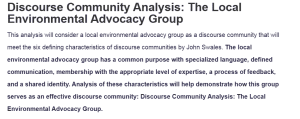Discourse Community Analysis: The Local Environmental Advocacy Group
This analysis will consider a local environmental advocacy group as a discourse community that will meet the six defining characteristics of discourse communities by John Swales. The local environmental advocacy group has a common purpose with specialized language, defined communication, membership with the appropriate level of expertise, a process of feedback, and a shared identity. Analysis of these characteristics will help demonstrate how this group serves as an effective discourse community: Discourse Community Analysis: The Local Environmental Advocacy Group.
A discourse community’s first trait is that it has a fixed set of common public goals (Swales). In the case of the local environmental advocacy group, their main aim is to advocate for sustainability and protect the local natural resources. This group typically supports policy changes, clean-up events, and environmental issues in the community. Members agree to and are united by this shared mission that leads to their joint activities.
Secondly, a discourse community has certain ways of communicating. Information is shared through social media, newsletters, and community meetings by this advocacy group (Jacobs 163). On these platforms, members regularly discuss ongoing projects and get support for upcoming events. Effective communication leads to a sense of community and promotes active participation among the members.
The third characteristic is the use of a specialized vocabulary. When the environmental advocacy group members speak, they often use terms like ‘sustainability’, ‘biodiversity’ and ‘carbon footprint’. The use of a shared language allows for clear communication and intertwines the group identity with expertise in environmental issues (Marius 459). This vocabulary is gradually picked up by new members, making them feel better integrated into the community.
The fourth identifying factor surfaces with regard to the genres of communication deployed by the community. The various written documents, including reports, flyers, and grant proposals, are produced by the local environmental advocacy group. Informing the public about events and seeking funding for projects are two different purposes, and each genre serves a purpose (Hyland 517). This diverse set of genres also demonstrates that the group was flexible in how it communicated in different contexts with different groups of people.
The discourse community also has a threshold number at which only that number of such experts are in the discourse community. Those who are members of the environmental advocacy group generally have studied environmental science, policy and education. They have a lot of expertise that helps them be able to meaningfully contribute to conversations and actually improve the group (Marius 459). The credibility and culture of learning are improved by the presence of knowledgeable members.
Lastly, the group has developed procedures for the supply of feedback and the encouragement of its members’ development. Open discussions are always held in regular meetings where we share ideas and critique projects that are in progress. The feedback loop enables group contributions to strengthen individual contributions and develop the group’s collaborative efforts. The advocacy group values input from all its members in order to create a collaborative atmosphere that fosters growth and innovation.
Mini-Reflection
By going through this analysis, I developed an awareness of what actually makes a discourse community and the importance of those defining characteristics. I learned that the commonality of purpose and communication strategies operate for the success of the local environmental advocacy group. Language and identity have been tested as components of building community dynamics by this exploration.
This has broadened my understanding of how these characteristics function in the group and will benefit me in the future towards effective communication and collaboration. All in all, this assignment stresses the importance of observing discourse communities because it facilitates the uncovering of the structures that allow the group to realize its purpose.
Works Cited
Hyland, Ken. “English for academic purposes and discourse analysis.” The Routledge handbook of discourse analysis. Routledge, 2023. 509-521.
Jacobs, Keith. “Discourse analysis.” Methods in urban analysis. Singapore: Springer Singapore, 2021. 151-172. https://doi.org/10.1007/978-981-16-1677-8_9
Marius, Richard. “Genre analysis: English in academic and research settings.” (1991): 458-460.
Swales, John M. Genre analysis. Cambridge university press, 1990.
ORDER A PLAGIARISM-FREE PAPER HERE
We’ll write everything from scratch
Question
NO, USING AI AT ALL:
In this module you are learning how you and others function within groups, specifically the discourse communities. After completing all the required readings and activities, you will carefully consider which discourse community you will analyze in your assignment culminating the module and conclude the writing with the required “Mini-Reflection.”

Discourse Community Analysis: The Local Environmental Advocacy Group
In this assignment you are completing an analysis of a chosen discourse community by applying to it all six characteristics of discourse communities.

